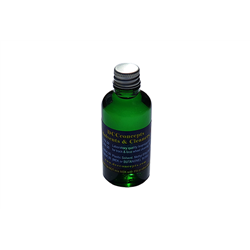Static grass puffer bottles work by manually charging model grass fibres with static electricity. When the charged...
No products
Product successfully added to your shopping cart
There are 0 items in your cart. There is 1 item in your cart.
Search Tips
How can I use IPA (Isopropyl Alcohol) to clean track?
Cleaning your model railway tracks with IPA (Isopropyl Alcohol) is an effective method to remove dirt, grime, and oxidation, ensuring good electrical conductivity and smooth operation. Here’s a step-by-step guide on how to use IPA to clean your model railway tracks safely and efficiently.
Materials Needed
- Isopropyl Alcohol (IPA)
- Ideally, use 70% or higher concentration for optimal cleaning efficiency.
- Microfibre Cloth or Lint-Free Cloth
- These are soft and won’t scratch the tracks, making them ideal for cleaning.
- Cotton Buds (Q-Tips)
- Perfect for reaching tight spaces and cleaning small areas.
- Track Rubber (Optional)
- You can use this for more stubborn dirt and grime before applying IPA.
- Small Container or Spray Bottle
- For applying the IPA more easily.
- Safety Gear
- Gloves and a mask are recommended if you are sensitive to fumes.
Step-by-Step Guide
Step 1: Prepare Your Workspace
- Ensure Safety: Make sure your working area is well-ventilated. IPA fumes can be strong, so open a window or work in a space with good airflow. If you're sensitive to fumes, wear a mask.
- Gather Materials: Assemble all the necessary materials mentioned above for a smooth cleaning process.
- Turn Off Power: Disconnect any power supplies to your track to ensure safety and avoid any electrical issues while cleaning.
Step 2: Initial Cleaning with a Track Rubber (Optional)
- Use a Track Rubber: If your tracks have significant dirt or oxidation, start by using a track rubber to gently scrub the rails. This will help remove any stubborn grime that might not come off with just IPA.
- Wipe Away Debris: Use a dry cloth to remove any debris left behind by the track rubber.
Step 3: Applying IPA
Dampen the Cloth: Pour a small amount of IPA into a container or spray bottle, then dampen your microfibre or lint-free cloth with the alcohol. Ensure the cloth is not soaking wet to avoid over-saturating the tracks.
Wipe the Rails: Gently wipe the rails with the dampened cloth, applying slight pressure to clean away dirt and oxidation. Be sure to move the cloth along the length of the tracks for consistent cleaning.
Focus on Areas of High Usage: Pay special attention to sections of the track that experience heavy usage, as they may accumulate more dirt and oxidation.
Step 4: Use Cotton Buds for Detailed Cleaning
Clean Hard-to-Reach Areas: Dip a cotton bud in IPA and use it to clean the hard-to-reach areas, such as rail joints, switches, and tight curves. This will ensure that every part of the track is thoroughly cleaned.
Precision Cleaning: Move the cotton bud along the track's inner edges and rail tops where contact with the train wheels is crucial.
Step 5: Dry and Final Wipe
Allow IPA to Evaporate: After cleaning, let the IPA evaporate naturally for a few minutes. IPA dries quickly, leaving no residue behind.
Final Wipe: Use a dry microfibre cloth to wipe down the rails one last time, ensuring no moisture or leftover debris remains.
Step 6: Reconnect Power and Test
Reattach Power Supply: Once the tracks are completely dry, reconnect the power supply.
Test Run: Run a train over the cleaned section to ensure smooth operation and good electrical contact. You should notice improved performance immediately.
Tips and Precautions
Frequency of Cleaning: Clean your tracks regularly, especially if you notice a decline in performance or visible dirt buildup. How often depends on usage, but monthly cleanings are a good starting point for active setups.
Avoid Overuse of IPA: While IPA is excellent for cleaning, excessive use can dry out plastic parts or affect painted areas. Apply it sparingly and only on the rails themselves.
Proper Storage: Store your IPA in a cool, dry place, away from direct sunlight. Ensure it is tightly sealed to prevent evaporation.
Safety First: If you’re cleaning a large setup, take breaks to avoid prolonged exposure to IPA fumes, and always follow any additional safety guidelines provided with your IPA product.
Use Track Cleaners with Care: While IPA is safe for most setups, always test on a small section of track if you are unsure how your specific materials will react.
Alternative Cleaning Methods
If you find IPA isn’t suitable or effective enough for your setup, consider these alternatives:
Commercial Track Cleaners: These are specially formulated for model railways and may include a combination of solvents that target specific types of grime.
Track Cleaning Cars: These are rolling stock designed to clean as they run on the track, often equipped with abrasive pads or liquid dispensers.
Homemade Solutions: Some hobbyists use a mixture of vinegar and water, although care must be taken to wipe thoroughly to avoid any potential corrosion from prolonged exposure.
Conclusion
Cleaning your model railway tracks with IPA is a straightforward and effective way to maintain performance and ensure your trains run smoothly. Regular maintenance with IPA can help prevent common issues like poor conductivity and track oxidation, keeping your model railway in top condition. By following these steps and precautions, you'll enjoy a consistently well-maintained track setup.
Click here to receive the tips weekly in your mailbox. You can unsubscribe at any time.









